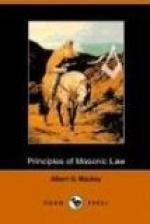And thus the interests of the institution continued, until the beginning of the eighteenth century, or for nearly eight hundred years, to be entrusted to those General Assemblies of the fraternity, who, without distinction of rank or office, annually met at York to legislate for the government of the craft.
But in 1717, a new organization of the governing head was adopted, which gave birth to the establishment of a Grand Lodge, in the form in which these bodies now exist. So important a period in the history of Masonry demands our special attention.
After the death, in 1702, of King William, who was himself a Mason, and a great patron of the craft, the institution began to languish, the lodges decreased in number, and the General Assembly was entirely neglected for many years. A few old lodges continued, it is true, to meet regularly, but they consisted of only a few members.
At length, on the accession of George I., the Masons of London and its vicinity determined to revive the annual communications of the society. There were at that time only four lodges in the south of England, and the members of these, with several old Brethren, met in February, 1717, at the Apple Tree Tavern, in Charles street, Covent Garden, and organized by putting the oldest Master Mason, who was the Master of a lodge, in the chair; they then constituted themselves into what Anderson calls, “a Grand Lodge pro tempore;" resolved to hold the annual assembly and feast, and then to choose a Grand Master.
Accordingly, on the 24th of June, 1717, the assembly and feast were held; and the oldest Master of a lodge being in the chair, a list of candidates was presented, out of which Mr. Anthony Sayer was elected Grand Master, and Capt. Joseph Elliott and Mr. Jacob Lamball, Grand Wardens.
The Grand Master then commanded the Masters and Wardens of lodges to meet the Grand Officers every quarter, in communication, at the place he should appoint in his summons sent by the Tiler.




